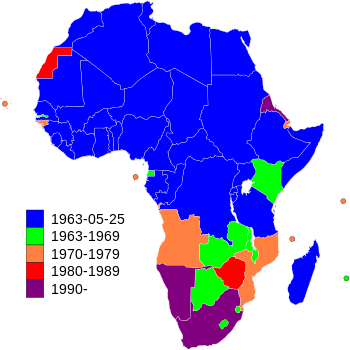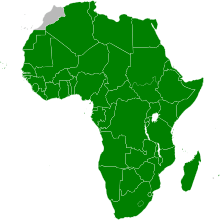Enlargement of the African Union
| Life in the African Union |
|---|
When the African Union (AU) was founded in 2002, it represented almost the entire African continent. As the successor to the Organisation of African Unity (OAU), founded in 1963, its membership was inherited from that body. Currently, the AU has 54 member states.[1] Growth in the OAU typically came from post-colonial independence; as decolonization ended, the borders of the OAU had overlapped almost all of Africa.
Membership
Article 29 of the Constitutive Act of the African Union (ratified July 11, 2000), states:
- Any African State may, at any time after the entry into force of this Act, notify the Chairman of the Commission of its intention to accede to this Act and to be admitted as a member of the Union.
- The Chairman of the Commission shall, upon receipt of such notification, transmit copies thereof to all Member States. Admission shall be decided by a simple majority of the Member States. The decision of each Member State shall be transmitted to the Chairman of the Commission who shall, upon receipt of the required number of votes, communicate the decision to the State concerned.
The following two articles discuss the suspension and cessation of membership:
- Governments which shall come to power through unconstitutional means shall not be allowed to participate in the activities of the Union.
and
- Any State which desires to renounce its membership shall forward a written notification to the Chairman of the Commission, who shall inform Member States thereof. At the end of one year from the date of such notification, if not withdrawn, the Act shall cease to apply with respect to the renouncing State, which shall thereby cease to belong to the Union.
- During the period of one year referred to in paragraph 1 of this Article, any Member State wishing to withdraw from the Union shall comply with the provisions of this Act and shall be bound to discharge its obligations under this Act up to the date of its withdrawal.
The former of these two clauses has been used to suspend the participation of states in the AU a number of times. The only state to leave the OAU was Morocco, which withdrew in 1984, following the admission of the Sahrawi Arab Democratic Republic in 1982. It is the only African state not currently an AU member.
Current members


Currently, the AU has 54 member states.[1] As the successor to the Organisation of African Unity (OAU), founded in 1963, its membership was inherited from that body. Growth in the OAU typically came from post-colonial independence; as decolonization ended, the borders of the OAU had overlapped almost all of Africa. When the AU was founded in 2002, it represented almost the entire African continent.
Possible growth
Morocco, the only UN Member state in Africa which is not a member of the AU, has made efforts to rejoin the organisation since its withdrawal in 1984.[2][3] Many leaders of African nations have supported the reintegration of Morocco to the AU.[4][5] In March 2013, the President of Côte d’Ivoire Alassane Ouattara stated that the heads of state of several Africa nations had pledged to begin efforts to reintegrate Morocco into the AU.[6] A couple of months later, President of Senegal Macky Sall expressed his support for Morocco rejoining the Union.[7] In July 2016, Morocco announced that it wished to rejoin the organization.[8]
In February 2012, the Caribbean state of Haiti signaled that it would seek to upgrade its observer status to associate member status.[9] The AU plans at its next summit in June 2013 to upgrade Haiti's status from observer to associate.[10]
Although the AU includes one largely unrecognised state, the Sahrawi Arab Democratic Republic, the prospects of the unrecognised African state of Somaliland being admitted to the organisation are slim. The AU continues to recognise the territorial integrity of Somalia, favouring the Transitional Federal Government's claim that Somaliland is an autonomous region over the Somaliland government's assertion of full sovereignty.[11] Nonetheless, Somaliland applied for AU membership in 2005, a request that has hereto gone unanswered.[11]
After Azawad's unilateral declaration of independence from Mali in 2012, the AU issued a statement calling the pronouncement "null and of no value whatsoever".[12]
See also
References
- 1 2 "Member States ------- * Member States under political sanction - African Union". Au.int. Retrieved 30 November 2014.
- ↑ Stevenson, Tom (2012-06-06). "Why Morocco must not be allowed to join the African Union". New Statesman. Retrieved 2013-02-01.
- ↑ "OAU considers Morocco readmission". BBC News. 2001-07-08. Retrieved 2012-03-25.
- ↑ Daouda, Aziz (2012-02-12). "Will Morocco soon return to the African Union?". Retrieved 2013-02-01.
- ↑ Tanjaoui, Zakariya (2013-03-14). "Morocco: King Tours Africa Countries, Gives New Impetus to South-South Cooperation". AllAfrica.com. Retrieved 2013-03-26.
- ↑ ""Morocco's place is within the African Union," Alassane Ouattara". 2013-03-22. Retrieved 2013-03-26.
- ↑ Jean-Matthew, Tamba (2013-05-16). "Senegal on a drive to have Morocco rejoin AU". Retrieved 2013-07-07.
- ↑ "Moroccan Envoy Meets with Kenyan President Over Rejoining African Union". Voice of America. 2016-07-15. Retrieved 2016-07-16.
- ↑ "Haiti - Diplomacy : Haiti becomes a member of the African Union - HaitiLibre.com : Haiti news 7/7". HaitiLibre.com. Retrieved 30 November 2014.
- ↑ Sampson, Ovetta (2012-02-29). "Long distance relationship: Haiti's bid to join the African Union". The Christian Science Monitor. Retrieved 2012-03-01.
- 1 2 "AU urged to prevent Somalia-Somaliland war". afrol News. 23 May 2006. Retrieved 16 June 2012.
- ↑ "Countries Dismiss Mali Rebel Claims of Independent Nation". Voice of America. 6 April 2012. Retrieved 16 June 2012.

.svg.png)